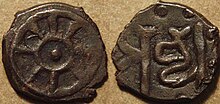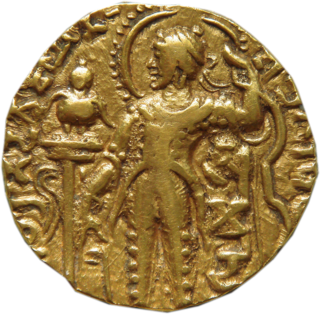| Achyuta of Panchala | |
|---|---|
 Coin of Achyuta | |
| King of Panchala | |
| Reign | c. 350 CE |
| House | Nagas of Panchala |
Achyuta Naga was the last independent ruler of Panchala, in what is now northern India. He was defeated by Samudragupta, a powerful Gupta emperor. [1]
| Achyuta of Panchala | |
|---|---|
 Coin of Achyuta | |
| King of Panchala | |
| Reign | c. 350 CE |
| House | Nagas of Panchala |
Achyuta Naga was the last independent ruler of Panchala, in what is now northern India. He was defeated by Samudragupta, a powerful Gupta emperor. [1]
Achyuta Naga was the last independent ruler of Panchala. He was defeated by the Gupta Emperor Samudragupta, after which Panchala was annexed into the Gupta Empire. [1]

The coins of Achyuta found from Ahichatra have a wheel of eight spokes on the reverse and the legend Achyu on the obverse. [2]
The early portion of the Prayag prashasti of Samudragupta mentions that Samudragupta "uprooted" three kings: Achyuta, Nagasena, and another ruler, whose name is lost in the damaged portion of the inscription. [3] [4] According to the inscription, Samudragupta reinstated these rulers after they sought his forgiveness. [5] [6]
It is not clear why these three kings' names are repeated later in the inscription. According to one theory, they were vassal rulers who rebelled against Samudragupta after the death of his father. Samudragupta crushed the rebellion and reinstated them after they sought his forgiveness. Later, these rulers rebelled once more, and Samudragupta defeated them again. [5] Another possibility is that the author of the inscription thought it necessary to repeat these names while describing Samudragupta's later conquests in Aryavarta, simply because these kings belonged to that region. [7]
The Gupta Empire was an ancient Indian empire on the Indian subcontinent which existed from the mid 3rd century CE to mid 6th century CE. It was the seventh ruling dynasty of Magadha. At its zenith, from approximately 319 to 467 CE, it covered much of the Indian subcontinent. This period has been considered as the Golden Age of India by historians, although this characterisation has been disputed by some other historians. The ruling dynasty of the empire was founded by Gupta and the most notable rulers of the dynasty were Chandragupta I, Samudragupta, Chandragupta II, Kumaragupta I and Skandagupta.

Chandragupta II, also known by his title Vikramaditya, as well as Chandragupta Vikramaditya, was the third ruler of the Gupta Empire in India. Modern scholars generally identify him with King Chandra of the Delhi iron pillar inscription.

Chandragupta I was a monarch of the Gupta Empire, who ruled in northern and central India. His title Mahārājadhirāja suggests that he was the first suzerain ruler of the dynasty. It is not certain how he turned his small ancestral kingdom into an empire, although a widely accepted theory among modern historians is that his marriage to the Licchavi princess Kumaradevi helped him extend his political power. Their son Samudragupta further expanded the Gupta empire.

Samudragupta (Gupta script: Sa-mu-dra-gu-pta, was the second emperor of the Gupta Empire of ancient India, and is regarded among the greatest rulers of India. As a son of the Gupta emperor Chandragupta I and the Licchavi princess Kumaradevi, he greatly expanded his dynasty's political and military power.

Kumaragupta I was an King of Kings of the Gupta Empire of Ancient India. A son of the Gupta kingChandragupta II and Queen Dhruvadevi. He seems to have maintained control of his inherited territory, which extended from Gujarat in the west to Bengal region in the east.

Gupta was the founder of the Gupta dynasty of northern India. He is identified with king Che-li-ki-to, who, according to the 7th-century Chinese Buddhist monk Yijing, built a temple near Mi-li-kia-si-kia-po-no (Mṛgaśikhāvana) for Chinese pilgrims.

The Licchavis of Nepal was a kingdom which existed in the Kathmandu Valley, Nepal from approximately 450 CE to 750 CE. The Licchavi clan originated from a branch of the Licchavis of Vaishali who ruled in the territory of modern-day Bihar and who later conquered the Kathmandu Valley. The Licchavis were ruled by a maharaja, aided by a prime minister and other royal officials, but in practice local communities were controlled by caste councils.

Ramagupta, according to the Sanskrit play Devichandraguptam, was an emperor of the Gupta dynasty of northern India. The surviving fragments of the play, combined with other literary evidence, suggest that he agreed to surrender his wife Dhruvadevi to a Shaka enemy: However, his brother Chandragupta II killed the Shaka enemy, and later dethroned him, marrying Dhruvadevi.

Skandagupta was a Gupta Emperor of India. His Bhitari pillar inscription suggests that he restored the Gupta power by defeating his enemies, who may have been rebels or foreign invaders. He repulsed an invasion by the Indo-Hephthalites, probably the Kidarites. He seems to have maintained control of his inherited territory, and is generally considered the last of the great Gupta Emperors. The Gupta genealogy after him is unclear, but he was most probably succeeded by Purugupta, who appears to have been his younger half-brother.

Ghatotkacha was a pre-imperial Gupta king of northern India. He was a son of the dynasty's founder Gupta, and the father of the dynasty's first emperor Chandragupta I.
The Malavas or Malwas were an ancient Indian tribe. The malavas are Malhi/malli people (Malloi) who were settled in the Punjab region at the time of Alexander's invasion in the 4th century BCE. Later, the Malavas migrated southwards to present-day Rajasthan, and ultimately to Madhya Pradesh and Gujarat. Their power gradually declined as a result of defeats against the Western Satraps, the Gupta emperor Samudragupta, and the Chalukya emperor Pulakeshin II.
There are conflicting theories regarding the original homeland and ancestry of the Gupta dynasty that ruled northern India between 4th and 6th centuries. Modern historians variously theorize that it originated in present-day Uttar Pradesh or Bengal, based on epigraphic, numismatic and literary evidence. The social group (varna) of the dynasty is also a matter of debate, with scholars variously placing them in Vaishya, Brahmana, or other categories.
Mi-li-kia-si-kia-po-no, believed to be a Chinese transcription of Mṛgaśikhāvana (Mriga-shikha-vana), was the site of a Buddhist establishment in eastern India. It is mentioned in the writings of the Chinese traveler Yijing, who states that king Che-li-ki-to had constructed a temple for Chinese Buddhist pilgrims near it.

The Naga dynasty ruled parts of north-central India during the 3rd and the 4th centuries, after the decline of the Kushan Empire and before the rise of the Gupta Empire. Its capital was located at Padmavati, which is identified with modern Pawaya in Madhya Pradesh. Modern historians identify it with the family that is called Bharashiva in the records of the Vakataka dynasty.
Dhruva-devi was the queen of the Gupta king Chandragupta II, who ruled in present-day northern India. She was the mother of his successor Kumaragupta I, and was most probably same as Dhruva-svamini, who has been mentioned as a queen of Chandragupta and the mother of prince Govindagupta in a clay seal inscription.

The Gupta era is a historical calendar era that begins from c. 318–319 CE. It was used by the Gupta emperors, as well as their vassals and their successors in present-day northern India and Nepal. It is identical to the Vallabhi era, which was used in the Saurashtra region of western India, although regional differences lead to a slightly different calculation for the conversion of Vallabhi era years to Common Era (CE).

Kacha was a king of India, possibly a member of the Gupta dynasty. He is known only from his gold coins, which are similar to those of the Gupta king Samudragupta.
Devi-Chandraguptam or Devi-Chandragupta is an Indian Sanskrit-language political drama attributed to Vishakhadeva, who is generally identified with Vishakhadatta. The complete text of the play is now lost, but its portions survive in form of quotations in the later works. The plot also survives in form of a Persian language story, which appears to be an adaptation of the play, and is included in the 11th century text Majmal-ut-Tawarikh.
Govindagupta was a Gupta prince of ancient India. He was a son of Chandragupta II and Dhruvadevi, and a brother of Kumaragupta.

The Gupta-Saka Wars refers to the military conflict between the Gupta Empire, ruled by Chandragupta II, and the Western shatrapas, also known as the Shakas, during the 4th century CE.